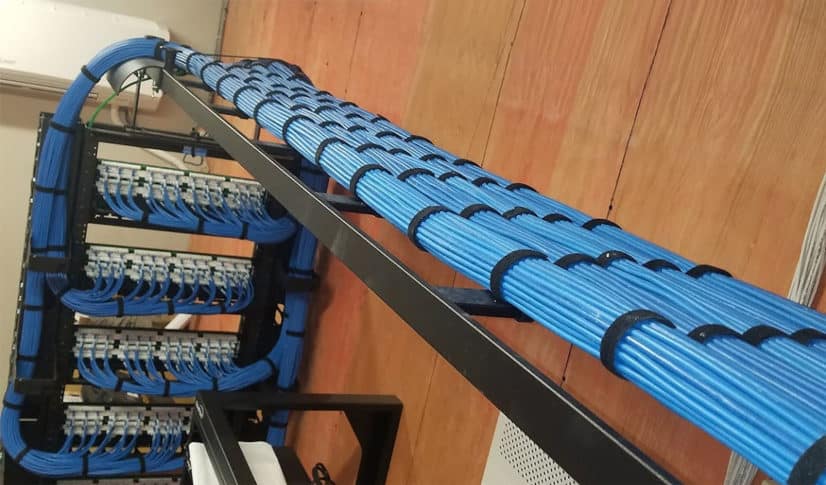Business owners are often dealing with fifty problems at once. A shoddy structured cabling system should never be one of them. In today’s business world, having a non or poorly functioning structured cabling system can spell disaster, both in terms of interrupting commerce, and potential security concerns.
Choosing the right structured cabling contractor can be a stressful endeavor. Having a basic knowledge of a reliable cabling installer’s process and the right questions to ask will save you a lot of time, money and headaches.
What Is a Structured Cabling System?
If pillars, girders and support beams comprise the skeletal structure of your building, then the structured cabling system is its brain and nervous system.
Put simply, structured cabling is your building’s and business’s telecommunications infrastructure. It consists of cabling and associated hardware. This will be the system that allows your voice, data, video, internet and security systems to function.
Structured cabling systems consist of six different subsystems.
- Entrance facility. The entrance facility is where the ISP’s wiring ends and the company’s wiring begins. It is known as the “demarcation point.” Everything beyond this point is the responsibility of the business owner. It also contains connecting hardware and protection devices.
- Equipment room. This is where you will find switches and routers — anything having to do with consolidation points for the system.
- Backbone cabling. Backbone cabling runs from the equipment room to the telecommunications room. It is typically fiber-optic cable or twisted-pair cable. This cabling runs throughout the system and is the cabling that ties the system together.
- Telecommunications room. This is the termination point for your backbone and horizontal cabling.
- Horizontal cabling. Horizontal cabling is similar to “last mile” cabling in that it is the last stretch of cabling before reaching a computer or other device in the building’s work area.
- Work area. This is the area where you will find the end-users’ equipment — laptops, desktops, iPads and so on.
What Should be Considered When Looking for a Structured Cabling Installer?
Like any service, showing that you know a little bit about it will reduce the odds that you are taken advantage of. You don’t have to know every detail about structured cable installation, just enough to know what some red flags might be.
Design. Be sure you know what to look for in structured cabling design. Most business owners know every nook and cranny of their facility. If the contractor’s plans show them running data cable alongside electrical cables, it might be a red flag. Electrical cables interfere with the magnetic field data cables need to work properly. If they run next to each other, the data cables might have to be reinstalled.
Other design issues to look out for are running lines close to fluorescent lighting and motors. Making sure your equipment room and entrance facility are well ventilated is crucial to making sure your equipment doesn’t overheat.
If a contractor plans on doing any of the above, don’t be shy about suggesting alternatives.
Hardware. This one is very important. Even cheap cable can be expensive. Oftentimes, purchasing the equipment for a structured cabling installation comes down to finding what the business can afford. There are many manufacturers of counterfeit cable in the market. These counterfeit cables can be very dangerous. The last thing you would want to do is put the safety of your employees at risk. Counterfeit cables frequently violate fire codes and are illegal to have installed. When considering employee safety, potential fines and poor network performance, it can be less expensive to purchase higher-quality cabling, even if it’s at a higher material cost.
One way to identify counterfeit cable is to look for a Underwriters’ Laboratories (UL) number. If you don’t see one, odds are you are looking at counterfeit, low-quality cable. A missing UL number is a huge red flag.
Testimonials. People in the trades take pride in their work. They want you to hear about the great job they did for the business down the street. Research the contractor’s online presence. Look for reviews. Not having easily accessible feedback from former and current customers might not be a good sign.
Quotes. When comparing price estimates from contractors, make sure that their quotes are detailed. Don’t get excited about one contractor’s quote being significantly less than another’s — this isn’t always a good thing. Remember that going cheap might cost you more in the long run.
Longevity. Do your due diligence by reading equipment reviews. You need this network cabling to last many years. If a contractor is using equipment that is outdated, you may find yourself having to do another installation or repairs down the road.
Certification. Having an up-to-date certification shows that the contractor stays current on state and local building codes. It shows that they take their job seriously and are knowledgeable about what can and cannot be done safely.
How Can Taylored Systems Help?
Taylored Systems prides itself on providing the best business solutions — from structured cable solutions to IT services — for clients in our service area. Our technical and design staff are BISCI and RCDD certified. We have been in business for 40 years, with the majority of our employees being with us for a decade or more.
If you are ready to take the next step in finding technology solutions for your business, we look forward to hearing from you.

